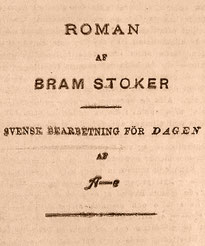Tidbits: an introduction to my research

These 18 "tidbit" pages will give you a quick and easy-to-understand overview of the research topics I contributed to, with tips for further reading. In some cases,
I merely expanded on theses proposed by other. In most instances, however, my work has led to genuine discoveries.
Discoveries form a special category of results. They happen within minutes, no matter how long it has taken to prepare the ground. And they lead to a sudden re-adjustment of our understanding. In the words of Professor Van Helsing:
"Just as there are elements which rest, yet when in nature's course they move on their way and they touch -- then pouf! and there comes a flash of
light, heaven wide, that blind and kill and destroy some; but that show up all earth below for leagues and leagues. Is it not so?"
I am proud to say that over the last ten years, I made more Dracula-related discoveries than any other scholar, and that my new paradigm
for Dracula Studies gradually finds acceptance.

These "tidbit" texts are offered for your convenience, to quickly understand my contribution to Dracula Studies. You can quote or paraphrase from them, just like from my detailed articles. To avoid plagiarism, don't forget to include the usual academic credits!
The Count
Who was Count Dracula during his lifetime? Why Vlad the Impaler is the only person who cannot have been the Count.
The Castle
Did Bram Stoker have a precise location in mind for his fictitious Castle Dracula, and if yes, can we find it on a map?
Carfax
What was the model for Carfax estate? Scholars have been looking for it in Purfleet —but it is somewhere else!
Scholomance
Stoker copied the idea of the Devil's School from Emily Gerard. But where exactly was Stoker's "Lake Hermanstadt" located?
Van Helsing
Stoker claimed that Van Helsing was based on a real person. Was he actually a hypnotist? Or a German professor all the same?
Lucy's tomb
Dracula says that Lucy's tomb was in "Kingstead," but Philip Temple believed that Hendon was meant. I took a look there.

The novel's timeframe
Elizabeth Miller was convinced that Dracula was set in 1893, but Leslie Klinger proposed an earlier year. What did Stoker intend?
Iceland
Since Dalby published the preface to Powers of Darkness, it has puzzled scholars. But it was just the tip of the iceberg!
Swedish Draculas
The Icelandic version of Dracula was based on a Swedish text. But who suspected there were two Swedish variants?!
Fact & fiction paradox
In some details, Dracula remains fuzzy. Was Stoker sloppy with his research, or did he obscure names and places on purpose?
Arthur's sister Mary
Arthur's "Icelandic" sister seems based on a real person, whose name was mentioned in Bram's notes. Pure coincidence?
Who was "A-e"?
The Swedish version of Dracula was translated and edited by "A-e." Who was hiding behind that pseudonym?
The Beheim fraud
McNally and Florescu claimed that the Count was based on Vlad the Impaler. But the capstone of their theory was a fake!
Hungary
The first Dracula serial appeared in Hungary. But did Jenő Rákosi really find the book on a London book fair?
Wadström
Since 1986, Dracula scholars have treated the Icelandic preface as a "canonical text." I discovered it was partly written by a pastor!
Inter Ocean serial
Specialized sleuths have been searching for American Dracula serials for decades. I happened to find the earliest one.
Lucy Western
The Chicago newspaper men had problems with spelling Lucy's surname. Is there a link with the Swedish version of Dracula?
Samuel S. McClure
In David Skal's Stoker biography, the American publisher Samuel McClure appears from nowhere. What about the early 1890s?

















